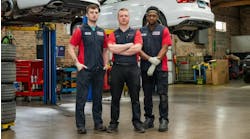While technician shortage statistics are familiar to the industry, the problem extends beyond the commercial vehicle maintenance sector. According to Wakefield Research, who surveyed 250 executives in manufacturing and field operations for BILT Intelligent Instructions’ “Technical Training in 2024” report, companies expect to lose 7% of their workforce to retirement and turnover in the next two years.
The mass wave of the Baby Boomers leaving the workforce has been called the Silver Tsunami, and its effects will wash away massive amounts of experience and capable hands. According to the U.S. Bureau of Labor statistics, there will be almost 68,000 openings for auto service technicians and over 24,000 openings for diesel mechanics each year until 2032.
“The automotive industry needs to backfill from those who left during COVID,” said Nate Henderson, CEO and chairman of BILT, a technology provider for vocational training and operational processes. “They also need to upskill an entire workforce on how to maintain electric and hybrid vehicles. An auto mechanic who graduated five years ago is unlikely to have any of those skills.”
With the current influx of more complex vehicle technology, those skills are crucial to maintaining uptime across the industry. And yet, making time to keep technicians fully trained is no easy task either. Upskilling comes at the cost of asking a technician to stop work and potentially travel to a training center.
But keeping technicians on their career path is equally difficult without proper training, Henderson noted.
This means that commercial vehicle shops and training programs need to understand the generation of workers coming into their facilities, adapt their educational methods to meet their needs, and allow all technicians the flexibility to complete their training without losing out on work.
Poaching versus farming
One option is to steal away trained talent from other shop or related trade.
"In this environment, companies become so desperate to hire they learn the next best thing to an already trained industry resource is someone who already understand mechanics, isn’t afraid to learn, is teachable and not afraid of getting their hands 'dirty,'" Henderson said. "The ramp up time for such a resource is 50% less than a fresh, untrained recruit."
This has its own downsides, though.
"In time however, companies tire of this poaching answer to filling the gap because it results in higher labor costs without a corresponding increase in value on the job, Henderson offered. "It may be a stop gap but the only long-term answer is to seed a new wave of workers."
There are plenty of ways to find this fresh crop of tecnhicians, from partnering with schools to find apprentices to job fairs. However you get them, the big thing to remember is that those new workers are vastly different from the ones set to retire, and require innovative new strategies of training.
Younger techs prefer hands-on training
To address this up-and-coming generation of workers, as well as the 15% of current technicians that prefer self-paced e-learning, working in new forms of augmented and virtual realities can replace the need for techs to travel to learn.
BILT's spatial computing app for Apple Vision Pro provides 3D instructions and animated, extended-reality diagrams in real space. This basically means the program can project component diagrams when used with an augmented-reality headset. Users can also access animated instructions and 3D diagrams on a phone or tablet.
This lets technicians use advanced technology while also learning as they work. The program can offer documentation, instructions, and work schematics without wi-fi access for a variety of fields.
“The application breaks down step by step the whole process from assembly to disassembly, including any stopping points that might be noted from previous research from the team,” said Kristopher McKenzie, BILT lead at Insulation and Piping Mechanic and the Norfolk Naval Shipyard (NNSY) T&I Lab. He led a pilot program between BILT and the NNSY to provide 3D maintenance instruction to its technicians in 2022.
“It tells you the tools you need, shows you virtually what goes where. You can pause each step, interact with the components, and see exactly how the job should look in person,” McKenzie explained.
As another example, apprentice electricians used the BILT 3D Intelligent Instructions at the 2022 IDEAL National Championship, where the ability to zoom in and rotate the digital images were helpful to identify small component elements, such as bolt threads.
BILT ensures their 3D/XR strategies work by tailoring each program for the industry it is for, including considering potential user ages, experiences, and how long they would need to complete tasks.
“Finishing strong is critical,” Henderson concluded. “It’s better to feed the user in small bites, then give them the option of jumping ahead if they are ready. Give them a solid path but the freedom to choose their own adventure.”
By advancing their training tools and programs, the commercial vehicle sector can work to trim down technician turnover in this generation of workers and the next.






